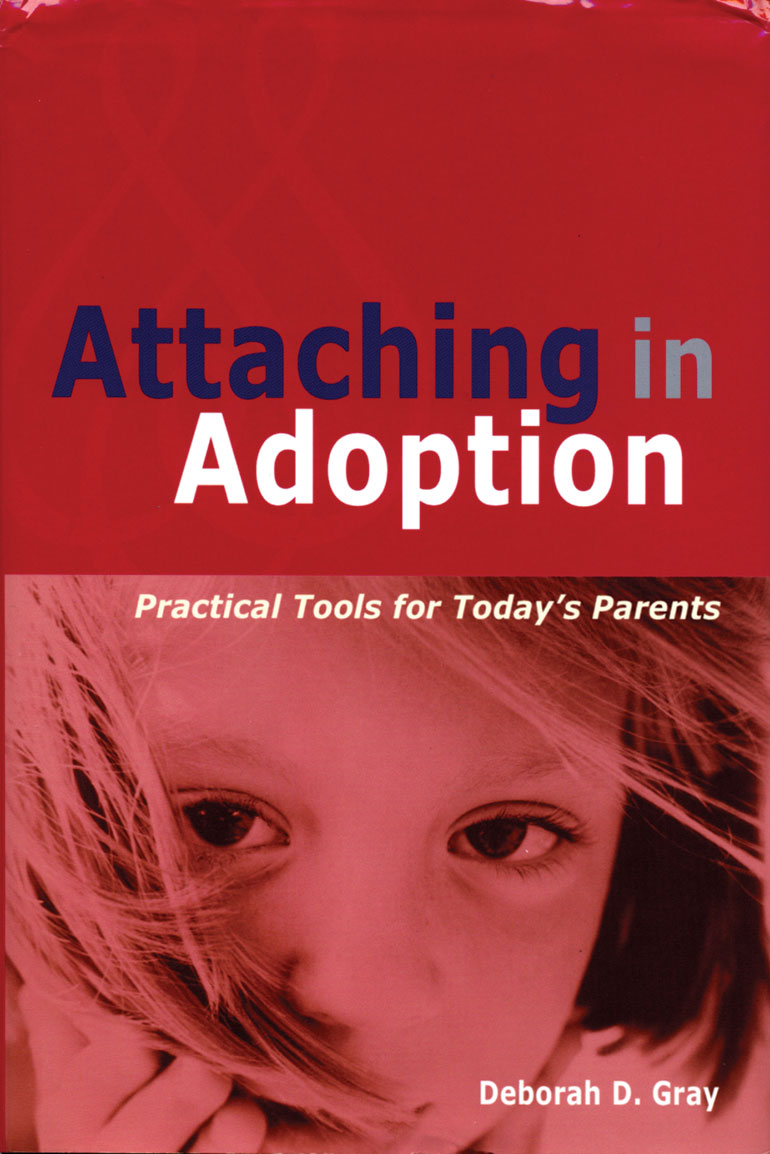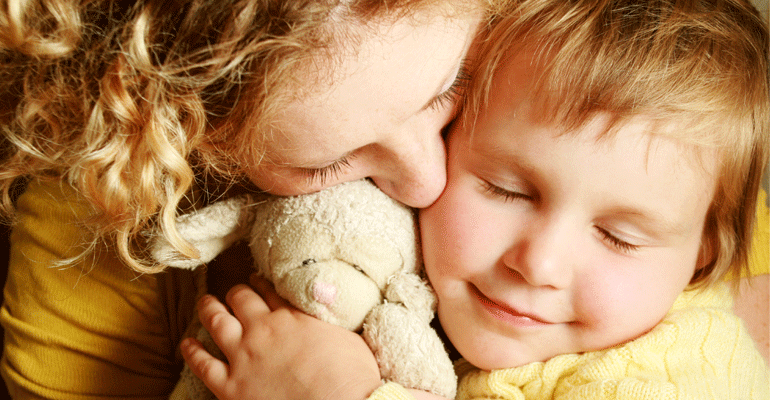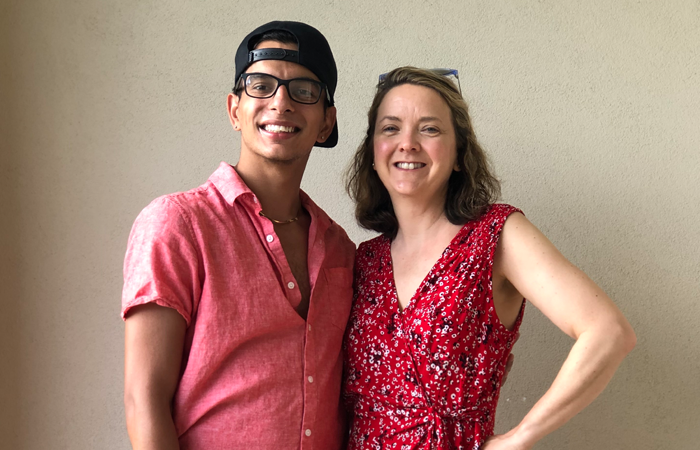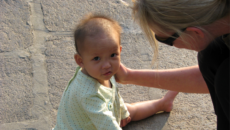Adoptive Families (AF): What are attachments?
Deborah Gray (DG): Attachments are close, lifelong relationships. A child will attach to a caregiver as she learns that she’s safe and that her needs will be taken care of.
Rather than becoming more dependent from close nurturing, children become trusting. A child who has not learned to depend on others will become anxious or emotionally constricted. He may engage in role reversal, and try to act as the parent in the family. Yet, his independence is false; he believes he can rely only on himself. The child who has learned healthy dependence is more secure in trying new things and venturing out. He understands that he doesn’t have to be perfect, and that he always has a safe home base to come back to — you!
AF: How can new adoptive parents begin forging a bond?
DG: Meet your little one’s needs in a consistent, sensitive manner. Feed on demand. Respond quickly to fussing. If you’ve adopted a toddler or older child, allow him to regress: Try bottle-feeding, rocking him to sleep, carrying him, and letting him sit on your lap. Create positive associations between yourself and food.
In short, be there for your child. Neurobiologic research shows that, when parents multitask, children can sense this. So turn off your computer and cell phone, block out your mental to-do list, and concentrate only on the relationship at hand. Restrict your hours away from your little one. That being said, don’t berate yourself or expect perfection. Understand that you have to manage real life, as well.
AF: How is the attachment process different for children at different ages?
DG: Children adopted as newborns are as primed to attach to you as though they had been born to you. The feeding, changing, carrying, singing, playing, and soothing that you’ll do in the course of everyday baby care will solidify that bond. Adoptive parents of newborns can relax some rules about allowing visitors in the home, and bonding and attachment should proceed smoothly.
For children adopted beyond infancy, Mom and Dad should be the ones who do all the nurturing. Your new little one needs to experience you as the safe person who is sensitively meeting her needs. I generally make an exception for grandparents, who hold a special place in the family. Other exceptions may be made on a case-by-case basis, of course. For example, if a child is joining a large family that uses a babysitter or relief helper on a daily basis, the helper should be introduced from the beginning as someone who is routinely in the home.
AF: Asking family to keep their distance sounds like it could be tricky. Can you suggest a way to phrase this request?
DG: You can explain: “My child is just learning what a family is. Right now he thinks anyone could be Mom or Dad. We have been told to strictly limit visitors at first, and to be the only ones to provide his care, so he can start making a connection with us. It is hard, as we are excited for you to meet your beautiful, new [nephew, cousin]. We appreciate your offers to drop off food or watch our other children in your home for a few hours. This is temporary, and we thank you for your understanding and patience.”
AF: What should a working parent look for in terms of child care?
DG: If — a big if — you can afford it, the best child-care situation for a newly adopted baby or toddler is in-home (your home) day care. Nanny care is wonderful because it doesn’t disrupt a child’s world. Studies have shown that children in every other type of day care have higher levels of the stress hormone, cortisol. The next-best type of care is small, family-based day care. [See “A Workable Bond,” for tips on smoothing the back-to-work transition.]
AF: How will you know when attachment is going right? How long will it take for a strong attachment to form?
DG: When children are growing in attachment, they show a clear preference for and investment in their parents. Does baby reach out for you and try to remain close to you? Does she keep an eye on you as you move about the room? Does she show a preference for being with you? Does she like to show you her toys? Some signs are less obvious — does he leave your side to try out new things, or does he cling and cry inconsolably if you put him down? [See “Signs of Healthy Attachment.”]
There’s no firm timeline for attachment, but it generally takes at least six months to establish the foundation of a strong parent-child bond. Think of your newly adopted child as being “on empty” in love and resilience, and understand that it will take a long time to fill him up. You should watch for signs of an exclusive attachment by the end of the first year.
AF: Do you recommend co-sleeping as a way of building attachment?
DG: This is absolutely a parental decision. Attachment and bonding in healthy, non-traumatized newborns will proceed reasonably, and parents shouldn’t feel pressured to co-sleep unless they want to.
For older children, the negatives may outweigh the benefits. A study conducted by Frank Putnam revealed that older children who have been traumatized have increased large-muscle movement and wake frequently, because they are more vigilant. This can make a dutiful parent who is trying to enhance attachment through co-sleeping become crabby and sleep-deprived—or snoring away in the guest bed. Think this decision through carefully!
AF: Some adoptive mothers worry about missing out on breastfeeding and the bonding that comes with it…should they?
DG: No, for two reasons. First, adoptive moms can at least partially breastfeed, if they really want to. [Read about adoptive breastfeeding.] Second, you can achieve the same critical intimacy through bottle-feeding. Hold your baby close, so he can feel and hear your heart beat. Provide skin-to-skin contact during some feedings. Make eye contact and speak in soft, positive tones. Let him know your focus is on him alone.
AF: Is there any baby gear you’d recommend to foster attachment? What should parents know about slings and baby carriers, in light of recent warnings about them?
DG: Slings and carriers are great ways to keep baby close to you, smelling your scent, hearing your heartbeat. Use one that allows you to always see your child’s face and doesn’t let him slide or ride in a curled position, with his chin touching his chest. Try not to spend too much time on the go. If you use a stroller, choose one that lets your child face you, rather than an umbrella stroller.
At home, don’t let your baby spend a lot of time in a portable car seat or a bouncy seat. In general, look for baby items that foster contact and exploration of her environment — keeping your presence in her world.
AF: What can stand in the way of attachment? What should parents watch for that might indicate that a child is having trouble attaching, and what should they do?
DG: Trauma and traumatic grief are the common culprits when children remain wary, fearful, and controlling of their parents. Signs of trauma in young children include frequent night terrors, dissociation (child shuts off emotionally and stares blankly), scratching, biting, extreme moods, freezing in place, and destructiveness. If you see such signs in your child, you should seek a mental health counselor.
A child who has spent his early years in a hostile environment needs to learn, and then practice, relationship skills for living in a safe family. He might not let down his defenses naturally. Attachment-oriented therapy with a trauma component, along with attachment parenting, can help. In my practice, which specializes in severe problems, the vast majority of children do improve in attachment, emotional modulation, and trauma symptoms.
If you adopt a toddler or older child who is having difficulty with attachment, do not set an artificial timeline of “fixed in a year.” Consider the year marker as the time it takes to really get to know your child — not to iron out every behavioral irregularity.
AF: What can parents do when the going gets tough?

DG: Self-talk is a wonderful way to enhance attachment. Turn off those automatic negative thoughts that afflict every new parent, and replace them with positive affirmations: “My daughter brightens up for me. I’m a great parent.” This causes neurologic firing, which shifts the whole system. Thinking of yourself as a good and strong parent helps your child think that way, too, and increases bonding. Positive thoughts build a scaffold for bonding and attachment — and, thus, for your family.



